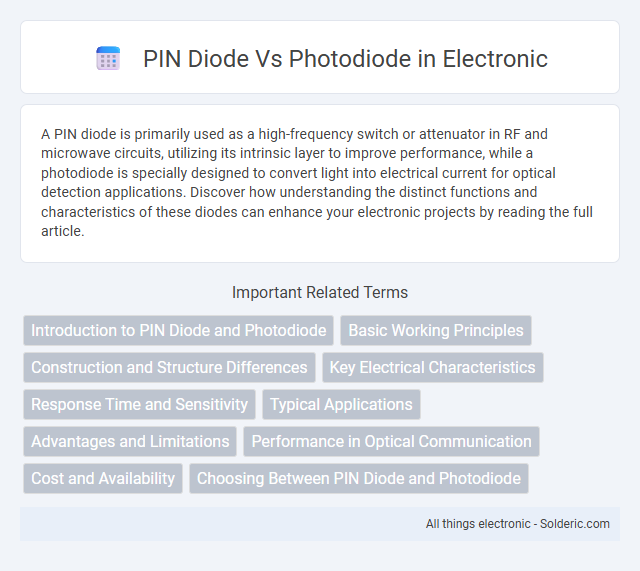A PIN diode is primarily used as a high-frequency switch or attenuator in RF and microwave circuits, utilizing its intrinsic layer to improve performance, while a photodiode is specially designed to convert light into electrical current for optical detection applications. Discover how understanding the distinct functions and characteristics of these diodes can enhance your electronic projects by reading the full article.
Comparison Table
| Feature | PIN Diode | Photodiode |
|---|---|---|
| Primary Function | High-frequency switching and RF power detection | Light detection and optical signal conversion |
| Structure | P-layer, Intrinsic layer, N-layer | P-N junction with intrinsic or depletion region |
| Operation | Voltage-controlled; used as a switch or attenuator | Photocurrent generated by incident light |
| Sensitivity | Low optical sensitivity | High optical sensitivity |
| Applications | RF circuits, attenuators, switches, mixers | Optical communication, light sensors, imaging |
| Response Time | Fast switching (nanoseconds) | Fast photoresponse (picoseconds to nanoseconds) |
| Biasing | Reverse biased for optimum performance | Reverse biased to increase sensitivity and reduce noise |
Introduction to PIN Diode and Photodiode
PIN diodes feature a wide intrinsic layer between the p-type and n-type regions, enabling efficient high-frequency switching and photodetection. Photodiodes convert light into electrical current with high sensitivity, commonly used in optical communication and sensing applications. Understanding your choice between a PIN diode and photodiode depends on whether the primary function prioritizes switching speed or light detection efficiency.
Basic Working Principles
PIN diodes operate as variable resistors in RF and microwave circuits by utilizing an intrinsic layer between the p-type and n-type regions, which modulates conductivity under different bias conditions. Photodiodes convert light into electrical current by generating electron-hole pairs when photons are absorbed in the semiconductor material, with variations such as PIN photodiodes offering faster response times due to the wider intrinsic region. The key difference lies in PIN diodes primarily controlling electrical signals through bias voltage, whereas photodiodes directly respond to optical signals via photon absorption.
Construction and Structure Differences
PIN diodes feature a layer of intrinsic semiconductor material sandwiched between p-type and n-type regions, creating a wide depletion region ideal for high-frequency and switching applications. Photodiodes, designed primarily for light detection, often have a similar p-n junction but are optimized with a thinner intrinsic layer to enable efficient photon absorption and faster response times. Your choice between these devices depends on the required electrical characteristics and sensitivity to light based on their distinct construction and structural variations.
Key Electrical Characteristics
PIN diodes feature a wide intrinsic layer that offers low capacitance and high-frequency performance, making them ideal for RF switching and attenuation applications. Photodiodes convert light into current with high sensitivity and fast response times, characterized by low dark current and high quantum efficiency. Your choice depends on whether you need control over RF signals (PIN diode) or precise photodetection and optical signal conversion (photodiode).
Response Time and Sensitivity
PIN diodes exhibit faster response times, typically in the nanosecond range, due to their intrinsic layer that reduces charge storage, making them ideal for high-speed switching and RF applications. Photodiodes, particularly those optimized for sensitivity, often have slower response times as they prioritize light absorption and quantum efficiency, capturing low-intensity signals with high accuracy. The sensitivity of photodiodes surpasses that of PIN diodes, with responsivities commonly reaching 0.6 to 0.7 A/W in the visible to near-infrared spectrum, crucial for precise optical detection.
Typical Applications
PIN diodes are commonly used in RF switching, attenuators, and photodetection due to their ability to handle high-frequency signals and fast switching speeds. Photodiodes are primarily employed in optical communication systems, light sensing, and imaging applications because of their sensitivity to light and fast response to varying light intensities. Both diodes are essential in telecommunications, but PIN diodes excel in electronic signal modulation, while photodiodes specialize in converting light into electrical signals.
Advantages and Limitations
PIN diodes offer advantages such as high-speed switching and low noise, making them ideal for RF and microwave applications, but they have limited sensitivity to light compared to photodiodes. Photodiodes excel in detecting light with high sensitivity and fast response times, perfect for optical communication and light measurement tasks, yet they generally have lower power handling capabilities. Your choice between a PIN diode and a photodiode depends on whether you prioritize light detection accuracy or electronic switching performance.
Performance in Optical Communication
PIN diodes exhibit high-speed switching and low noise, making them suitable for detecting weak optical signals in fiber optic communication systems. Photodiodes, especially avalanche photodiodes (APDs), provide internal gain and higher sensitivity, improving performance in long-distance or low-light optical communication links. While PIN diodes excel in linearity and response time, photodiodes enhance signal detection in challenging optical environments through amplification mechanisms.
Cost and Availability
PIN diodes generally have lower costs and higher availability due to their widespread use in RF and microwave applications, making them a budget-friendly choice for many electronic designs. Photodiodes, while slightly more expensive, are specialized components optimized for light detection and are readily available from numerous manufacturers focused on optical sensors. Your decision depends on the balance between cost-efficiency and the specific optical performance required for your application.
Choosing Between PIN Diode and Photodiode
Choosing between a PIN diode and a photodiode depends on the application requirements such as speed, sensitivity, and wavelength response. PIN diodes excel in high-frequency RF switching and attenuation due to their wide intrinsic region, while photodiodes are optimized for light detection with high responsivity and low noise in optical communication systems. Evaluating factors like bandwidth, quantum efficiency, and operating environment guides the selection process to ensure optimal device performance.
PIN diode vs photodiode Infographic

 solderic.com
solderic.com